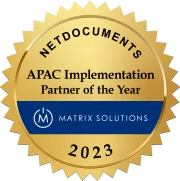Managed Disaster Recovery Services
Matrix Solutions’ Managed Disaster Recovery Services – Seamless Security, Swift Recovery
Understanding Managed Disaster Recovery
In today’s business landscape, data is a crucial component of operations. Implementing Managed Disaster Recovery (MDR), a proactive approach, helps prevent unexpected disasters from causing significant harm to an organisation’s critical data, systems, and operations.
Matrix Solutions’ MDR services are part of managed IT services that offer a variety of services, including:
- Real-time Monitoring
- Rapid Response Mechanisms
- Minimal Downtime
MDR is more comprehensive than traditional disaster recovery solutions, as it combines state-of-the-art technology with the expertise of third-party providers to ensure the safety of your critical data, systems, and operations. It serves as a strategic safety net, going beyond mere recovery protocols.
Why Managed Backup
Benefits of Managed Disaster Recovery Services
Implementing Managed Disaster Recovery (MDR) services for your business offers numerous benefits beyond disaster recovery. These benefits include:
Swift Reaction Time:
Managed Disaster Recovery Services enable quick and efficient response times in the face of unexpected disasters or disruptions. In the unpredictable landscape of business, time is of the essence. Swift reactions ensure that your organisation can mitigate the impact of disruptions promptly, maintaining operational continuity and client trust.
Enhanced Flexibility:
These services provide flexibility in adapting recovery strategies to diverse scenarios, ensuring adaptability to evolving business needs. The business environment is dynamic, and adaptability is key. Enhanced flexibility allows your organisation to tailor recovery approaches, ensuring that no matter the challenge, your operations remain resilient.
Optimised Resource Usage and Improved Control:
Managed Disaster Recovery optimises resource allocation, leading to improved control over the recovery process. Efficiency is the cornerstone of success. By optimising resources, you enhance cost-effectiveness and gain better control over your recovery efforts, enabling a smoother and more controlled recovery process.
Upholding Reputation Integrity:
Disaster recovery services help maintain a positive reputation by minimizing downtime and ensuring that business commitments are met. Your reputation is invaluable. Upholding your commitment to clients and stakeholders, even in challenging times, strengthens trust. Managed Disaster Recovery Services act as a shield, safeguarding your reputation and fostering long-term relationships.
Types of Managed Disaster Recovery Services
At Matrix Solutions, we have tailored MDR solutions that fit every unique need of your business.
Cloud-Based Disaster Recovery
Cloud-Based Disaster Recovery stands out as a dynamic and resilient solution. This service uses cloud technology to securely back up your critical data and systems, making it easy to restore them quickly from cloud repositories in case of disasters. With unparalleled accessibility, scalability, and flexibility, Cloud-Based Disaster Recovery helps your business adapt to changing requirements seamlessly.
Self-Service DRaaS (Disaster Recovery as a Service)
The “as-a-service” model means that the organisation doesn’t have to own all the resources or handle all the management for disaster recovery; instead, it relies on the service provider. Self-service DRaaS empowers you with a platform to manage and orchestrate your disaster recovery processes actively.
Third-Party Managed Service Providers
Third-Party Managed Service Providers take charge of your entire disaster recovery strategy, from planning and implementation to continuous monitoring. By outsourcing to experts, you benefit from industry best practices. They leverage their experience and knowledge, incorporating cutting-edge technologies and methodologies into your disaster recovery strategy.
Onsite and Offsite Backup Solutions
Tailor your disaster recovery approach with Onsite and Offsite Backup Solutions. Onsite backups offer immediate accessibility and rapid recovery, while offsite backups provide secure, geographically diverse storage options. This dual strategy ensures a comprehensive and resilient backup architecture, minimising risks associated with both local and wide-scale disruptions.
Your Trusted Partner for Managed IT Services in Australia
Matrix Solutions earned the honor of being a NetDocuments Platinum Partner for its outstanding sales performance, impressive earnings, extensive maintenance of NetDocuments certifications, and achievement of high customer satisfaction scores.

How DRaaS Operates as a Service
Disaster Recovery as a Service (DRaaS) works by providing a comprehensive and outsourced solution to safeguard an organisation’s data and IT infrastructure in the event of a disaster or disruptive incident. Here’s a simplified explanation of how DRaaS works:
Assessment and Planning
The process begins with a thorough assessment of the organization’s IT environment and potential risks. A detailed disaster recovery plan is then crafted based on identified vulnerabilities and critical business processes. By understanding your unique infrastructure and risks, DRaaS ensures a tailored approach, optimising the effectiveness of the recovery strategy.
Data Replication and Backup
DRaaS involves continuous data replication and backup. Critical data and applications are duplicated in real-time or at scheduled intervals to a secure offsite location. Your data is your lifeline. With constant replication, DRaaS ensures that your essential information is mirrored and ready for recovery, reducing the risk of data loss.
Virtualisation Technology
Virtualisation is a key component of DRaaS. It allows for the creation of virtual copies of servers, storage, and networks. In the event of a disaster, these virtual resources can be activated quickly, reducing downtime. It adds a layer of agility and enables rapid deployment of IT resources, ensuring that your critical systems can be up and running swiftly, minimising the impact on your operations.
Automated Failover and Failback
DRaaS automates the failover process, redirecting network traffic and operations to the replicated environment when a disaster is detected. Once the primary site is restored, a seamless failback occurs. Automation is the key to speed. Automated failover and failback processes reduce human error and ensure a quick, efficient transition between environments, keeping your business running smoothly.
Testing and Monitoring
Regular testing of the disaster recovery plan ensures its effectiveness. Continuous monitoring of the IT infrastructure allows for proactive identification of potential issues. Practice makes perfect. Regular testing ensures that your recovery plan is always fine-tuned and ready. Monitoring adds a layer of proactive protection, identifying and addressing potential threats before they escalate.
Scalability and Customisation
DRaaS solutions are scalable, allowing organisations to adjust resources based on their evolving needs. Customisation ensures that the solution aligns with specific business requirements. Flexibility is key in a dynamic business landscape. DRaaS provides the scalability and customisation needed to adapt to changes in your organisation, ensuring the continuity of your operations.
Considerations when Choosing a Provider for Your Business
Security & Compliance Measures:
Thoroughly examine the security and compliance measures offered by MDR (Managed Detection and Response) providers. MDR providers should implement encryption and access controls and adhere to industry regulations to ensure your data is recoverable and safeguarded against potential breaches.
Service Level Agreements (SLA):
Understand the provider’s SLAs for the commitments regarding recovery times, system availability, and the level of support provided. Clear SLAs lay the foundation for a transparent and accountable partnership.
Costs & Pricing Structures:
Look for a pricing model that aligns with your budget and provides a clear breakdown of expenses, ensuring no hidden costs down the line.
Preparing for Disasters with Careful Planning:
Assess how well your provider prepares for disasters. A complete disaster recovery plan should include more than just technology. It should also include specific strategies for communication, allocation of resources, and alternative operational procedures.
Developing a Comprehensive Disaster Recovery Plan:
Examine the provider’s capability to customise a disaster recovery plan for your company that includes recovery objectives, prioritises critical functions, and outlines a roadmap for swift and effective recovery.
Testing Your Disaster Recovery Plan:
Regular testing is the litmus test for the effectiveness of your disaster recovery plan. Consider your provider’s commitment to conducting routine tests to validate your plan in real-world scenarios. This proactive approach instils confidence in the reliability of the plan.
Responsibilities and Procedures When Disaster Strikes:
Ensure that the provider establishes a framework for immediate response when disaster strikes. This includes communication protocols, escalation procedures, and allocating roles to minimise confusion during critical times.
What are DRaaS Operating Models
Beyond being a mere solution, DRaaS stands as a versatile toolkit, offering your business the flexibility to customise its approach. The three DRaaS models are:
- Managed DRaaS
- Assisted DRaaS
- Self-Service DRaaS
Managed DRaaS
When you opt for the Managed DRaaS model, you delegate the entire disaster recovery process to a specialised service provider. This means they will care for everything, including planning, implementing, and monitoring the recovery strategy. As a result, you can enjoy a hands-free experience, allowing your internal resources to focus on your core business functions.
Assisted DRaaS
Assisted DRaaS allows you to balance external assistance and your involvement. In this model, you can actively participate in specific aspects of the recovery process while relying on the expertise of your service provider. They will guide and support you in key tasks, promoting a collaborative approach. This cost-effective model enables you to contribute to the recovery process while benefiting from the DRaaS provider’s guidance and resources.
Self-Service DRaaS
The Self-Service Disaster Recovery-as-a-Service (DRaaS) model allows you to manage and orchestrate your disaster recovery processes proactively. This hands-on approach enables you to customise recovery plans, monitor real-time activities, and actively participate in decision-making throughout recovery. While providing greater control, the self-service model requires more internal expertise and involvement. It is ideal if you have in-house capabilities and prefer autonomy in shaping and executing your disaster recovery strategies.
FAQs on Managed Disaster Recovery Services
Why use Managed Disaster Recovery?
As a business that relies on technology, any significant issue can cause a major outage, resulting in substantial financial loss. That’s why you need a Managed Disaster Recovery service provider who can quickly identify and report any issues to the right people and ensure that everything automatically starts working again once they fix your problem.
How much money will your business lose while critical equipment or applications are down?
Based on the 2021 survey polled 1,200 corporations across 28 different industries, ITIC found that 91% of the interviewed corporations incur a cost of $300,000 or more for a single hour of server downtime.
How do you recover from a critical system or data failure?
Matrix Solutions takes steps to streamline your recovery process when facing a critical system or data failure. It involves swiftly identifying and fixing the issue and quickly returning to normal operations. In addition, it minimises downtime, preventing substantial financial losses.
What will happen to key data in the event of a disaster?
In this scenario, Matrix Solutions’ managed disaster recovery service takes centre stage, ensuring that your crucial data is not lost. Through advanced backup and recovery strategies, this solution safeguards your key data, allowing for seamless restoration after a disaster. So, even in challenging times, your essential information remains protected and accessible.
Contact Us
Have any inquiries or feedback for us? Fill out the form below to contact our team.
"*" indicates required fields
Office is in Sydney
+61 (0)2 9233 3548
in**@*****************om.au
The team at Matrix Solutions have been an integral part of our success over the past two decades. It’s like having an enterprise level IT department in the next room.
Cas AntunesDirector: Antunes Lawyers
Since 2008, we have relied on the team at Matrix Solutions to handle all of our IT needs. The MatrixCloud hosted desktop has allowed us to work from anywhere without interruption.
John QuinnPrincipal: John R Quinn & Co.
The team at Matrix Solutions have a great understanding of the technical requirements of a law firm. Their prompt service and communication delivers to our firm a valued advantage.
Leanne WarrenPrincipal: Leanne Warren & Associates

Need to Kickstart Your Business?
Strategy, technology, and design are the cornerstones of developing strong user experiences that support your needs and strengthen your business.



